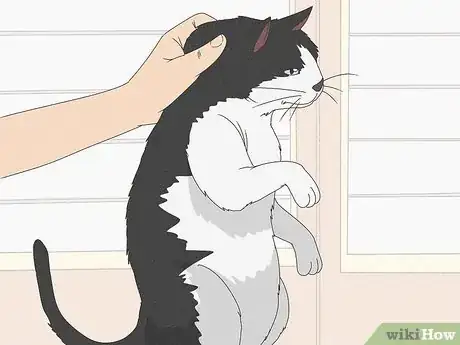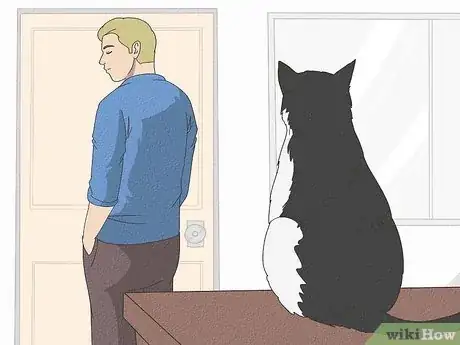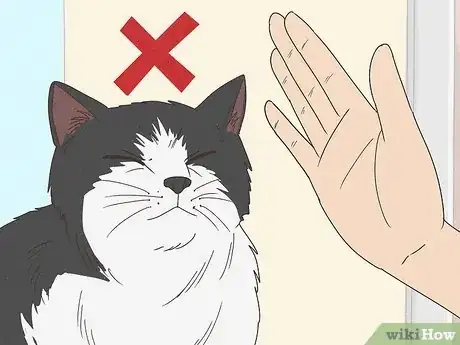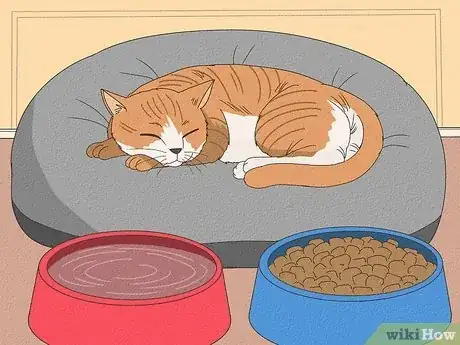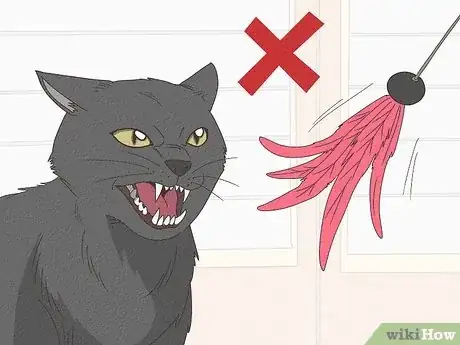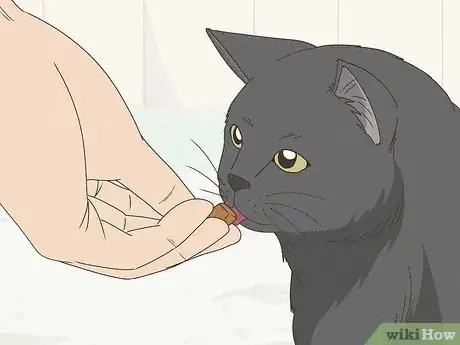This article was co-authored by Brian Bourquin, DVM. Brian Bourquin, better known as “Dr. B” to his clients, is a Veterinarian and the Owner of Boston Veterinary Clinic, a pet health care and veterinary clinic with three locations, South End/Bay Village, the Seaport, and Brookline, Massachusetts. Boston Veterinary Clinic specializes in primary veterinary care, including wellness and preventative care, sick and emergency care, soft-tissue surgery, dentistry. The clinic also provides specialty services in behavior, nutrition, and alternative pain management therapies using acupuncture, and therapeutic laser treatments. Boston Veterinary Clinic is an AAHA (American Animal Hospital Association) accredited hospital and Boston’s first Fear Free Certified Clinic. Brian has over 19 years of veterinary experience and earned his Doctor of Veterinary Medicine from Cornell University.
This article has been viewed 54,344 times.
An aggressive cat can be hard to deal with, but it's important to remember that the cat is either afraid or was poorly socialized as a kitten. They may attack you, other people, or other animals in your house. To calm an aggressive cat during an attack, you need to give it space and divert its attention away from the fight. To change an aggressive cat's behavior in general, you need to get to the root of the animal's behavior and make it feel safe and comfortable. If you are unable to calm your aggressive cat on your own, you can also seek out help from an animal professional, such as a veterinarian or an animal behaviorist.
Steps
Ending an Aggressive Outburst
-
1Protect yourself during an attack. If you are actively being attacked by an aggressive cat, you should protect yourself the best you can. Remember that a cat's best weapons are its teeth and its claws, so try to avoid contact with both. Your best option is to stay away from the cat and avoid handling it if possible.
- If you must touch the cat, try to hold it by the scruff so that it can't get you with its claws or teeth. You can also try to wrap it in a towel or blanket, as this can disable the animal.
- Shield your most vulnerable body parts with your arms if a cat is trying to latch on to you. Your most sensitive areas should be prioritized, including your eyes and face.
-
2Move away from the cat. If a cat is exhibiting body language that is aggressive or striking out at you, you should move away from it. Getting out of striking distance can keep you safe and reduce the animal's anxiety as well.
- Moving closer to reassure the cat or to try to calm it down will likely only increase its defensiveness. This may result in an even more aggressive attack.
- Avoid looking directly into the cat's eyes, as this is a sign of an aggressive challenge.
- If the cat is in your lap when it becomes aggressive, stand up so that the cat falls away from you. Then quickly move away from the cat.
Advertisement -
3Interrupt aggressive behavior. If possible, sidetrack a cat that is acting aggressively. Sometimes this can be done by engaging it with a toy it likes. You can also make a sharp noise that will scare or shock it, such as a clap or a hiss.[1]
- You can also drop something that will make noise on the floor, such as a container full of pennies. A noise maker like this is good to have on hand if you have a cat that becomes aggressive often.
- If the cat is fixated on a specific thing, try to break eye contact. Put something between the cat and what it becoming aggressive towards.
-
4Break up a fight without getting involved. If your cat is acting aggressively towards another animal, you should try to break up the fight and move the other animal to a safe space. However, you should never get in between the animals, as this is dangerous for you and could result in injury. In many cases, this can be done by giving the animals an escape route away from the fight, such as by opening a door.
- You can also try surprising the aggressive cat to disorient it by throwing a towel or a bucket of water onto it. This should give you the chance to get the other animal out of the situation.
- It is important to protect all your animals from fighting. You should not let them simply fight it out. This can lead to serious injuries and hard feelings between the animals in the long term.[2]
- It is especially important to separate animals that you are trying to acclimate to each other, such as when you add a new pet to your home. A fight early on in their relationship can make it strained well into the future.
- Try putting something between the fighting cats that will stop them from making contact with each other. For example, a pillow can be placed between the animals before they make physical contact.
-
5Avoid giving physical punishment.[3] Even light physical punishment, such as bopping the animal on its nose, can increase its anxiety. Instead of reducing aggression, this type of reaction can increase its severity.[4]
- Never hit a cat. An aggressive cat needs your help, not more aggression added to the situation.
-
6Give the cat its own space. After an aggressive episode, it's best to let the cat decompress and calm down on its own. Don't interact with it until it has calmed down and it comes to you for interaction or attention.[5]
- You may even want to keep it sequestered in a room by itself with food, water, and a litter box. However, some cats will not like this and it will increase their aggression.
- Some cats just simply need to be left alone a lot of the time. If you have a moody cat that simply wants to be left alone, give that to them. Give them their own space where they can be away from people and other animals in your home, such as a spare bedroom.
- Make sure each room in your home has a hiding place, such as a cardboard box, where the cat can retreat. Hiding helps cats deal with stress.
-
7Treat any cat scratches or bites properly. If you, your cat, or another animal gets injured, you should make sure the injuries are treated appropriately. Cat scratches and bites should be cleaned, disinfected, and bandaged so that they do not become infected. If injuries do become infected, get them treated by a doctor or veterinarian.
- Signs of infection to a cat scratch or bite include pain, redness, swelling, and puss coming from the injured area.[6]
- Cat bites and scratches are prone to infection, so it's important to thoroughly clean and disinfect them even if they seem minor.
Getting Professional Help
-
1Have the cat assessed for health problems. In some cases, aggression can be caused by an underlying health problem. If your cat feels sick, it may act out with aggression to let you know that it is ill. To eliminate this as a possible cause of your cat's aggression, have your cat examined by its veterinarian.[7]
- Some medical conditions that can cause aggression include arthritis, dental problems, and hyperthyroidism. Some common symptoms associated with these illnesses include a lack of appetite, trouble moving, vomiting, and diarrhea.[8]
- If your cat is acting aggressively, your veterinarian may need to restrain it while examining it. Be aware that this kind of restraint is for the protection of the veterinarian and the cat itself.
-
2Discuss behavior solutions with your vet. Even if your vet doesn't find anything medically wrong with your cat, they may still be able to help with the problem. Ask them about medications that might help your cat calm down and for any other solutions they may have.
- Ask your vet about the over-the-counter products that might be helpful as well. Your veterinarian is likely to know the best calming sprays and diffusers on the market.
-
3Contact a pet behavior specialist. There are animal professionals that can help you if you have a severely aggressive cat. A pet behaviorist can work on behavior modification and can teach you how to interact safely and positively with your cat.
- You can typically find a pet behavior specialist in your area through your veterinarian, your local animal shelter, or online.
Changing Aggressive Behavior
-
1Start your intervention early. If a cat is displaying aggressive behavior early in life you should try to change it quickly. Eliminating aggressive behavior in a young cat or kitten can prevent it from becoming a habit.[9]
- Even if a cat is older it is still worth your time to try and reduce its aggression. The cat will simply take more time to change its behavior than a young cat would.
-
2Figure out what is causing the aggression. To minimize the cat's aggression, you need to get to the root of the problem. Start by thinking about what has changed in the animal's life that may be giving it anxiety. Also, be on the lookout for what happens to and around the cat right before an episode. If you can figure out where the aggression is coming from, you may be able to mitigate it. Some common reasons for aggression include:[10]
- Fear
- Defensiveness
- Conflict with other animals
- Redirected anger
- Territorial feelings
- Predatory aggression
- Overstimulation
- Rough play excitement
- Maternal protection
- General irritability
- Pain
- Thyroid issues
- Lack of attention
- Change in location
- Past trauma
-
3Identify the signs that your cat is about to become aggressive. There are typically some warning signs that your cat is going to become aggressive before it strikes out. By identifying them, and stopping the stimulus that is causing the behavior, you can sometimes avoid the incident altogether. While each cat's behavior before an aggressive episode can differ, some common signs include:[11]
- Crouching or squatting
- Tucking the head down
- Wide eyes with dilated pupils
- Retracted whiskers
- Hissing or spitting
- Putting its hackles up
- Ears flattened back
-
4Make adjustments that will ease your cat's aggression. If you have figured out that your cat's aggression has a specific cause, make any possible adjustments that will eliminate the cause. Some issues can be eliminated by making changes to the cat's living situation or interactions. For example, if your cat gets aggressive when you play roughly with it, stop that kind of play.[12]
- If your cat has a hard time with other animals, it might be best to keep it as an only pet.
-
5Reward good behavior. As you are trying to change your cat's behavior, it is important to let the animal know when it is doing a good job. Rewarding the cat with treats or a game it likes to play when it is acting nicely is a good way of showing it the right kind of behavior.
- For example, if your cat gets aggressive when it is petted for too long, reward it when it doesn't exhibit this behavior. Pet it lightly for a few moments in your lap and before the interaction goes awry set it on the floor. Then give it a treat for its good behavior. If you repeat this process, the cat will eventually learn that it gets something it likes if it does not strike out in anger.
References
- ↑ http://www.vet.cornell.edu/fhc/Health_Information/brochure_aggression.cfm
- ↑ https://www.petsit.com/dealing-with-aggressive-cats
- ↑ Brian Bourquin, DVM. Veterinarian. Expert Interview. 20 December 2019.
- ↑ http://www.vet.cornell.edu/fhc/Health_Information/brochure_aggression.cfm
- ↑ http://www.vet.cornell.edu/fhc/Health_Information/brochure_aggression.cfm
- ↑ https://www.urmc.rochester.edu/encyclopedia/content.aspx?contenttypeid=90&contentid=P01897
- ↑ https://www.aspca.org/pet-care/cat-care/common-cat-behavior-issues/aggression-between-cats-your-household
- ↑ http://www.vet.cornell.edu/fhc/Health_Information/brochure_aggression.cfm
- ↑ http://www.vet.cornell.edu/fhc/Health_Information/brochure_aggression.cfm
About This Article
To calm an aggressive cat, be on the lookout for whatever is triggering its aggressive outbursts right before they happen. For example, your cat might be lashing out because it doesn't get along with your other pet, or it could be territorial when someone gets close to its food. Whatever the reason, you want to identify it so you can make adjustments in your home to reduce or eliminate your cat's triggers. For example, if your cat is aggressive when your other pet is around, you might want to keep them separated as much as possible. If you can't figure out why your cat is acting aggressive, take it to the vet for a checkup. Sometimes, aggression can be a sign of an underlying health problem, and your vet will be able to figure out what's going on and recommend the best treatment plan. For advice from our Veterinary co-author, like how to shut down one of your cat's aggressive outbursts, keep reading.
